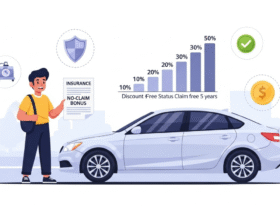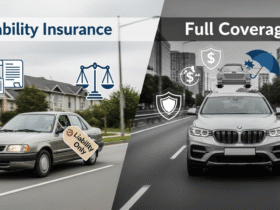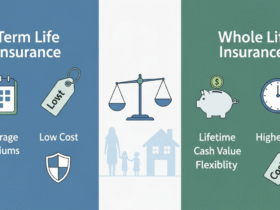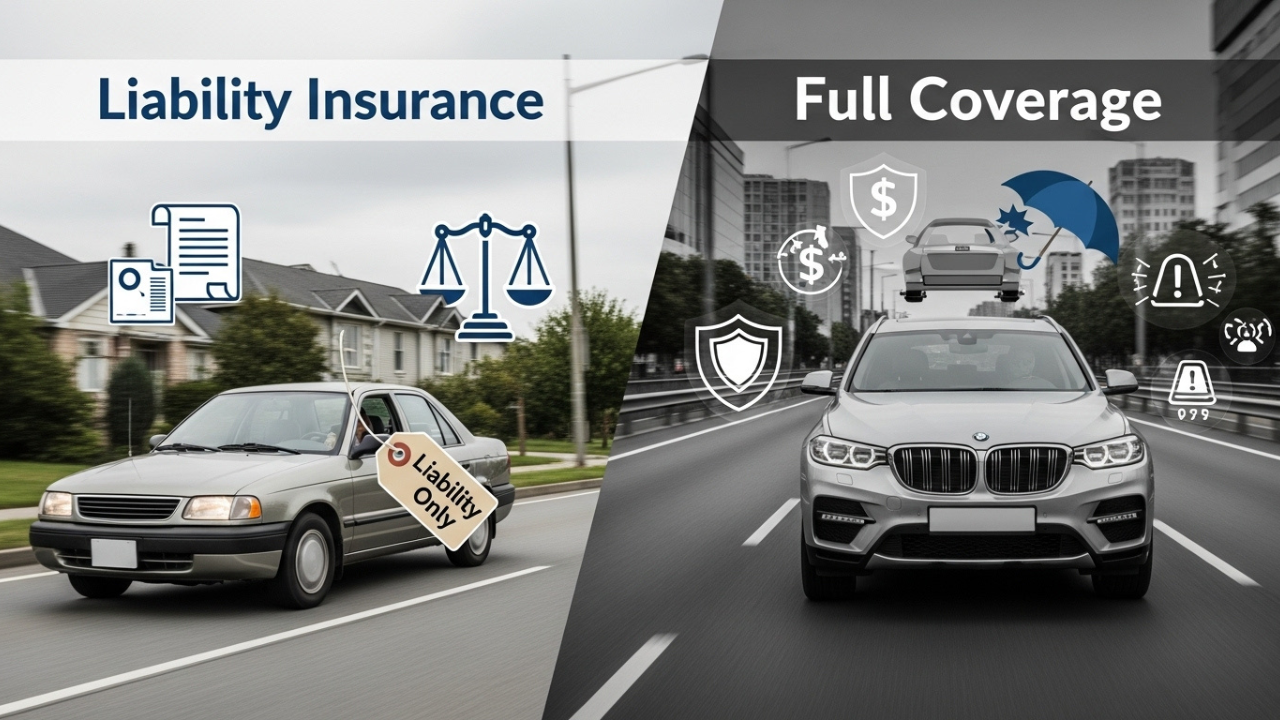Navigating auto insurance can feel daunting as you weed through what exactly you need. A common source of bafflement amongst drivers, whether a novice or a veteran, is discerning the real difference between liability insurance and full coverage. Both types of insurance provide protection, but the insurance attach different forms of safeguards.
Choosing the wrong insurance type can leave you financially vulnerable, while the right one can safeguard you. It is important to recognize what these coverages mean, how they work, and when each makes the most sense for you. Let me walk you through it as simply as possible so you can make an informed choice that aligns with your unique requirements.
Key Takeaways
- Damages to others caused by you are covered; full coverage encompasses this and adds protection for your own vehicle.
- Liability coverage is mandated legally in most states; full coverage is usually required by lenders for financed or leased cars.
- Liability is inexpensive; full coverage costs more due to broader protection.
- Your own vehicle damage is not covered under Liability; Full Coverage pays for damages resulting from accidents or non-collision events.
- Your vehicle’s worth, your driving style, and finances determine how you choose from the two options.
Understanding Liability Insurance: What It Really Means for You
Liability Insurance is the most familiar type of insurance and is legally required in most states. It has a minimum limit, so coverage can be purchased in higher amounts. Liability coverage will kick in if you cause an accident and a third party is injured or some property is damaged.
This policy type is usually split into two components: bodily injury liability and property damage liability. Injured people involved in the accident are also eligible for medical treatment, hospitalization, and in some cases, reimbursement for wages not received during the recovery period. Property damage liability settles the bills for mending the other driver’s vehicle and any other things that you might have damaged, like a fence, a light post, or even a house wall (as odd as it may sound, this is more common than you would think).
What liability insurance does not cover is your own medical expenses or the damage to your vehicle. That is certainly something to keep in mind. If you’re involved in an accident and it’s your fault, liability insurance only covers your losses.
Why Liability Insurance Is Required
You may be asking why it is required at all. The reasoning is clear: it provides some form of protection to other individuals on the road. Most states have laws that set a minimum liability limit for insurance. These laws are designed to make sure that if you make a mistake, there is coverage available for other people who are not at fault. Different states have different limits so make sure to know the exact amounts required where you live.
That said, these minimums might not be sufficient in the event of a serious accident. All medical attention necessary after an injury, in addition to vehicle repairs, is tremendously costly. If you’re deciding on liability only insurance, having limits higher than the minimum requirement is wiser.
Breaking Down Full Coverage: What You’re Really Paying For
Let us now discuss full coverage–a term that lack of understanding accompanies. People assume full coverage pertains to every single insurance claim imaginable. This is not correct. The term “full coverage” gives a vague outline policy combinations whose structure widens beyond mere liability.
“Full coverage” constitutes of:
“Collision Insurance”, which takes care of the expenditures of damages incurred on your vehicle as a result of an accident, regardless of whether you were the reason behind it.
“Comprehensive Insurance”, covers losses such as fire, theft, vandalism, hail storms, falling trees and more that does not involve colliding with another vehicle.
Full coverage policies act as umbrellas and oftentimes allow for more coverage. This includes_ “uninsured or underinsured motorist protection”, which helps in the case that there is someone who hits you and does not have insurance. Moreover, medical payments coverage also assists in offsetting your medical expenses paying for them, irrespective of the person responsible.
Why Full Coverage Might Be a Better Fit for You?
You likely have full coverage insurance if you drive a newer car, a leased car, or one that is financed. That is because the lender has a financial stake in it. The vehicle is collateral for the loan, so it needs to be insured sufficiently.
If no one is enforcing full coverage, it can still be a good decision. Ask yourself this — if your car gets totaled tomorrow, can you buy another out of pocket? If no, then full coverage could be worth the high premium. Full coverage is not just protecting your vehicle, but your financial future as well.
Comparing the Two: Liability vs. Full Coverage in Real Life
Imagine you own a ten-year-old car that with the most is valued at a couple of thousand dollars. You do not have further payments on the vehicle, do not drive out of town, and have an e-fund stocked away. This is the kind of scenario where only having liability insurance is beneficial. Why pay extra for complex coverages like collision or comprehensive insurance when your vehicle isn’t truly worth that much?
Now envision a different situation; you just bought a brand new SUV on finance. It was your dream car and you intend to use it on a daily average to shuttle to work and pick up the kids. Surprise expenses of $15,000 are bound to be out of the question for you. In such a situation, voiding full coverage would be very difficult. One will certainly want that protection—a necessity, though it comes with a price to the monthly premium.
When to Consider Dropping Full Coverage
There is a natural progression in every vehicle’s life where full coverage might stop being relevant. At a certain point, if the car is worth less than $4000, it is likely that over the year the vehicle’s premiums will be paid and that’s it.
As with most things, there is a tipping point for everyone, but it is helpful to analyze how the cost of coverage measures up alongside your car’s current valuation. Just remember that cancelling full coverage would mean taking on additional risk, since in the event of theft or a total loss, you’d be liable for covering the replacement cost yourself if only basic liability coverage is maintained.
How to Decide: Liability or Full Coverage?
As always, it depends on your situation. Here’s what I’d suggest you ask yourself:
- What’s the current market price for your vehicle?
- Are you still paying off a loan on the vehicle?
- Can you afford to self-insure in the event a claim is made on the vehicle?
- How often and where do you drive?
- Are you comfortable with increased financial exposure and risk?
If you’re considering liability because it is cheaper, ensure you’re comfortable with the risks. On the other hand, if you’re considering full coverage for peace of mind, make sure to comparison shop and adjust your deductible to something that is realistic for your budget.
Final Thoughts: Making the Smart Choice for You
The choice between liability and full-coverage auto insurance impacts your finances, peace of mind, and how you navigate life’s surprises on the road. There is no universal solution — it depends on your individual circumstances.
If your vehicle carries significant value, requires intensive driving due to your schedule, or you are still servicing a loan, then full coverage makes sense. On the other hand, older cars and tight budgets make liability coverage a reasonable option.
No matter what decision you arrive at, remember to conduct a review of the policy with your insurance agent regularly. Consider circumstantial changes—aging of the vehicle and change in finances—and likewise adjust the insurance. Talk to your provider, ask them the right questions, and share your genuine needs. With greater understanding of options available, it would be easier for you to protect what matters most—on and off the road.




























Leave a Reply